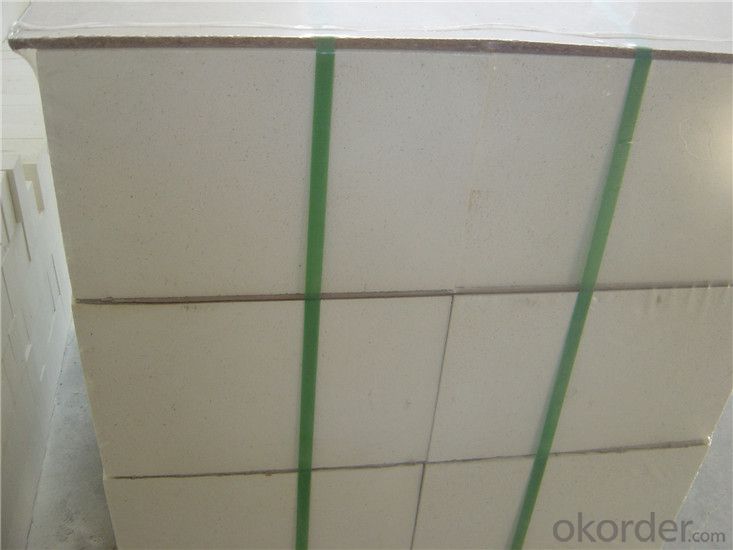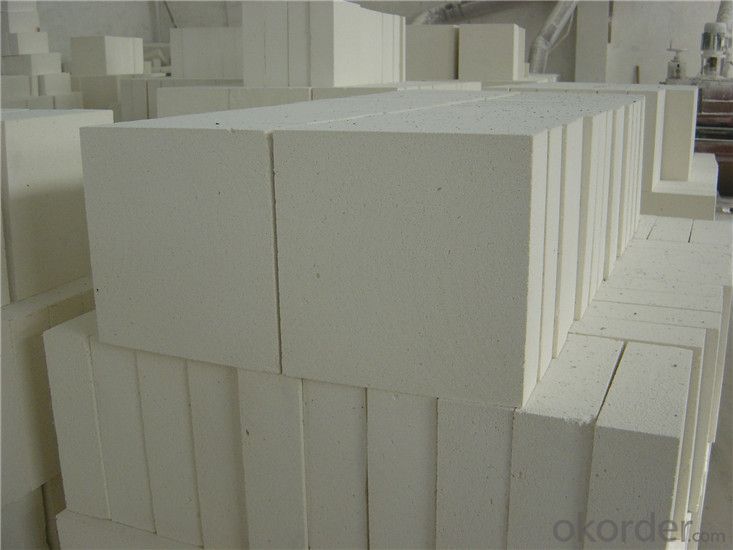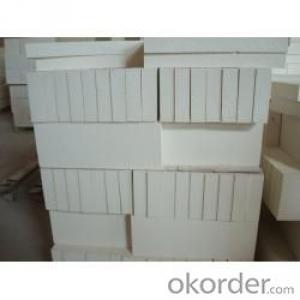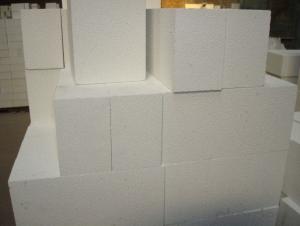Mullite Thermal Storage Bricks Thermal Insulating Brick
- Loading Port:
- Shanghai
- Payment Terms:
- TT OR LC
- Min Order Qty:
- 1 m.t.
- Supply Capability:
- 1000 m.t./month
OKorder Service Pledge
OKorder Financial Service
You Might Also Like
CNBM conforms strictly to the requirements of ISO 9000 quality control system during the production. MSDS is also available if you want. The thermal insulation fire clay brick meet with the requirements of ASTM & JIS standards. So please stay cool with our quality.
Application
Insulating Fire Brick are used for the lining of converter, alternating current arc furnace, direct Current arc furnace and the ladle slag line, etc.
Insulating Fire Brick Technical index
Brand Quality | JM23 | JM26 | JM28 | JM30 | JM32 | |
Bulk Density (g/cm3) | 0.52 | 0.78 | 0.88 | 1.03 | 1.25 | |
1.2 | 1.6 | 2.1 | 2.5 | 3.5 | ||
Modulus of Rupture (Mpa) | 0.9 | 1.4 | 1.6 | 2.1 | 2.1 | |
-0.5 | 1400℃ -0.4 | 1510℃ -0.5 | 1620℃ -0.9 | 1730℃ -0.9 | ||
Thermal Expansion 1100℃(%) |
0.5 |
0.7 |
0.8 |
0.9 |
1.1 | |
Thermal conductivity(W/m.k)
| 400℃ | 0.14 | 0.27 | 0.32 | 0.41 | 0.49 |
600℃ | 0.16 | 0.29 | 0.34 | 0.43 | 0.50 | |
800℃ | 0.18 | 0.31 | 0.36 | 0.44 | 0.51 | |
1000℃ | 0.20 | 0.33 | 0.38 | 0.45 | 0.53 | |
Al2O3 | 37 | 58 | 67 | 73 | 77 | |
Fe2O3 | 0.7 | 0.7 | 0.6 | 0.5 | 0.4 | |
Equipment
1 unit of Ceramic Abrasive (SG Abrasive) pilot production line
2 units of Compact grain Abrasive pilot production lines
1 unit of high-end coated abrasives (abrasive cloth) production line
2 units of Boron Carbide production lines
3 large flexible crushing and sieving lines for grit production lines
2 units of 2000KVA furnaces for Boron Carbide fusion
6 units of 5000KVA-10000KVA dumping type electric arc furnaces for Brown Fused Alumina fusion
Company Advantage
(1)Long Insulating Fire Brick manufacture history: 25 years manufacturer
(2)Advanced equipment
(3)Diversification of production standards: ISO ANSI FEPA JIS ASTM
(4)Flexible payment: T/T L/C D/P D/A
(5)Professional marketing team and after-sale service
(6)Free sample


- Q:Do insulating fire bricks require any special firebrick mortar for installation?
- Yes, insulating fire bricks do require a special firebrick mortar for installation. Regular mortar is not suitable for insulating fire bricks because it may not provide the necessary thermal insulation properties or withstand the high temperatures that these bricks are designed to handle. Insulating firebrick mortar is specifically formulated to withstand extreme temperatures and to bond well with insulating fire bricks. It is typically made from a combination of refractory materials, such as high-alumina cement, silica sand, and fire clay. Using the correct firebrick mortar is crucial to ensure a strong and durable installation of insulating fire bricks.
- Q:Do insulating fire bricks require any special anchors or supports for installation?
- Special anchors or supports are necessary for the installation of insulating fire bricks in certain applications. These bricks are lightweight and have low thermal conductivity, making them suitable for high-temperature environments like furnaces, kilns, and fireplaces. However, their lightweight nature can cause them to move or shift under certain conditions. To ensure the stability and integrity of the insulating fire bricks, it is important to use special anchors or supports during installation. These anchors or supports are typically made of metal, such as stainless steel, and are designed to securely hold the bricks in place. They prevent the bricks from shifting or falling out, especially when exposed to vibrations, thermal expansion/contraction, or other external forces. The specific type and design of the anchors or supports depend on the application and installation requirements. Common types include V anchors, U anchors, and L anchors, which can be embedded into the surrounding refractory material or attached to a structural frame. The anchors or supports should be spaced and installed correctly according to the manufacturer's guidelines to ensure sufficient support and stability of the insulating fire bricks. In conclusion, although insulating fire bricks offer excellent thermal insulation properties, they require special anchors or supports for installation to prevent movement or displacement. These anchors or supports are crucial for maintaining the structural integrity and longevity of the insulating fire brick system.
- Q:Do insulating fire bricks have a low coefficient of thermal expansion?
- Yes, insulating fire bricks have a low coefficient of thermal expansion. This means that they expand and contract very little when exposed to high temperatures. Insulating fire bricks are specifically designed to withstand extreme heat and maintain their structural integrity. Their low coefficient of thermal expansion helps them to resist cracking or breaking due to thermal stress. This property makes them ideal for applications such as insulation in furnaces, kilns, and other high-temperature environments where thermal stability is crucial.
- Q:Can insulating fire bricks be used for insulation in cryogenic applications?
- Yes, insulating fire bricks can be used for insulation in cryogenic applications. Insulating fire bricks are made from lightweight refractory materials with low thermal conductivity, which makes them highly effective in reducing heat transfer. Cryogenic applications require insulation materials that can withstand extremely low temperatures and prevent heat leakage. Insulating fire bricks have excellent thermal stability and can maintain their insulation properties even at cryogenic temperatures. They are commonly used in cryogenic storage tanks, pipelines, and other equipment to provide insulation and minimize heat transfer.
- Q:Can insulating fire bricks be used in the construction of glass melting furnaces?
- Insulating fire bricks are indeed applicable for constructing glass melting furnaces. These bricks are specifically designed to possess exceptional heat resistance and endure exceedingly high temperatures. Their low thermal conductivity allows for efficient heat retention and minimal heat loss. In glass melting furnaces, where temperatures can reach up to 1600°C (2912°F) or even higher, insulating fire bricks serve a pivotal role in maintaining the desired temperature within the furnace. By utilizing these bricks as the lining for the furnace, the heat generated during the melting process can be effectively contained, resulting in improved energy efficiency and reduced heat loss. Additionally, insulating fire bricks are lightweight and exhibit remarkable thermal shock resistance, making them highly suitable for glass melting furnaces that experience sudden temperature fluctuations. This ensures that the bricks will not crack or break under the extreme conditions present in the furnace. Overall, incorporating insulating fire bricks into the construction of glass melting furnaces offers superior insulation, energy efficiency, and durability, rendering them an ideal choice for this application.
- Q:Are insulating fire bricks resistant to thermal shock cracking?
- Insulating fire bricks exhibit resistance against thermal shock cracking. These bricks are engineered to endure elevated temperatures and sudden temperature variations without experiencing cracks. With their low thermal conductivity, they efficiently capture and retain heat while remaining unharmed by thermal shock. Consequently, insulating fire bricks find frequent application in contexts where thermal shock poses a potential hazard, such as furnaces, kilns, and other environments with high temperatures. Their dependable resistance to thermal shock cracking renders them a trustworthy selection for such applications.
- Q:Are insulating fire bricks resistant to hydrofluoric acid?
- Yes, insulating fire bricks are resistant to hydrofluoric acid.
- Q:Are insulating fire bricks resistant to thermal spalling?
- Insulating fire bricks exhibit resistance to thermal spalling, which is the process of a material cracking or fracturing as a result of abrupt fluctuations in temperature or thermal shock. These bricks are specifically engineered to endure elevated temperatures and thermal cycling without spalling. Their low thermal conductivity allows for efficient insulation against heat transfer, thereby reducing the strain caused by thermal expansion and contraction. Moreover, the composition and structure of insulating fire bricks are meticulously designed to offer outstanding protection against thermal spalling, rendering them a dependable option for applications involving intense heat conditions.
- Q:Are insulating fire bricks resistant to carbon monoxide attack?
- Insulating fire bricks have a general resistance to carbon monoxide attack. They are made from materials that can withstand high temperatures and chemical corrosion, including carbon monoxide. These bricks are commonly used in environments where high temperatures and exposure to gases like carbon monoxide are frequent, such as furnaces, kilns, and fireplaces. The composition of the bricks allows them to endure long periods of exposure to carbon monoxide without deteriorating or reacting with the gas. However, it is important to remember that continuous exposure to extremely high levels of carbon monoxide can eventually harm any material, including insulating fire bricks. Therefore, it is still crucial to ensure proper ventilation and safety precautions when dealing with carbon monoxide in any situation.
- Q:Can insulating fire bricks be used in the construction of refractory-lined vessels?
- Yes, insulating fire bricks can be used in the construction of refractory-lined vessels. Insulating fire bricks have excellent thermal insulation properties and can withstand high temperatures, making them suitable for lining vessels that require heat insulation and refractory properties.
1. Manufacturer Overview |
|
|---|---|
| Location | |
| Year Established | |
| Annual Output Value | |
| Main Markets | |
| Company Certifications | |
2. Manufacturer Certificates |
|
|---|---|
| a) Certification Name | |
| Range | |
| Reference | |
| Validity Period | |
3. Manufacturer Capability |
|
|---|---|
| a)Trade Capacity | |
| Nearest Port | |
| Export Percentage | |
| No.of Employees in Trade Department | |
| Language Spoken: | |
| b)Factory Information | |
| Factory Size: | |
| No. of Production Lines | |
| Contract Manufacturing | |
| Product Price Range | |
Send your message to us
Mullite Thermal Storage Bricks Thermal Insulating Brick
- Loading Port:
- Shanghai
- Payment Terms:
- TT OR LC
- Min Order Qty:
- 1 m.t.
- Supply Capability:
- 1000 m.t./month
OKorder Service Pledge
OKorder Financial Service
Similar products
New products
Hot products
Related keywords



























